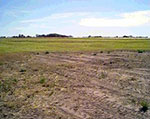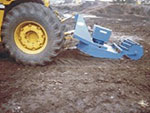|
You here: Ecology Lignohumate in soil amelioration.

Acceleration of growth rates of economic development involves piling up industrial wastes, and all kinds of environmental disasters, which results in accumulation of dangerous and toxic matters in soil, including heavy metals (HM) and radionuclides. This, in turn, adversely affects soil ecosystems, growth of plants and contents of noxious matters therein. At that, vegetation may seem normal; however, accumulation of HM and other toxic matters will make food products unsafe and unacceptable for human nutrition. HM are known to cause metabolic derangements in plants, viz., increase in contents of nitrogen, decrease in phosphorus, calcium, magnesium, and iron; chlorophyll concentration drops particularly steeply. Also, HM strongly affects phosphoric metabolism, leading to decrease in contents of organic phosphates. Excessive HM concentration negatively affects synthesis and functioning of many biochemically-active components such as enzymes, vitamins, pigments, etc.
Soil is also affected by HM; its productive capacity decreases because of soil microorganisms' sensitivity to metals that reflects the response of soil biota to contamination. Reduction in nitrogen-fixing microorganisms' activity is particularly manifest. Soil amelioration is one of possible ways to mitigate negative effects of contamination; this may primarily be achieved through increase in humus content, since poor soil is more vulnerable to contaminants.
Humic substances contained in Lignohumate, due to their high-molecular structure, act as effective sorbents of HM, radionuclides and other noxious matters harmful to plants and microorganisms. Humic substances would fix contaminants via sorption complexing mechanism, thus preventing their migration with ground waters and reducing the level of their biological absorption, which results in ecological advancement. Recommended humic preparation's sowing rate directly depends on a degree of soil contamination and concentration of humic substances in used preparation. Thus, when amount of caesium is below 1 kg per hectare, at least 1 kg of Lignohumate per hectare shall be applied. If amount of caesium is 1 to 5 kg per hectare, Lignohumate sowing rate shall also be 1 to 5 kg per hectare. For soils strongly contaminated with heavy metals recommended Lignohumate application rate is 20 to 30 kg per hectare. This enhances probability of contacts between Lignohumate reactants and heavy metal ions, and boosts complexing.
Research works demonstrated high effectiveness of the technology in question, in terms of soil fertility, productivity, and crop quality. Thus, application of up to 10 kg Lignohumate per hectare of permanent grasses for the 1st year resulted in increase in green mass by 38,5-52,6%. Moreover, the increase in crop for the next year amounted to 6%, with no Lignohumate application. Large amount of organic material remaining in soil after grass mowing in form of plant roots is rapidly processed by microorganisms activated with Lignohumate, which substantially boosts humus generation in soil. As early as in three years since the beginning of said technology application, humus content increased by 0,83-0,99%, which, in case of podzolic soil (with average humus content of 2,0-2,5%) means relative growth by 30-45%.

Intensification of soil microorganisms activity through use of humic preparations constitutes yet another way of soil amelioration. Lignohumate distinguishes itself among other humic preparations with presence of fulvic and other low-molecular acids. Therefore, its high-molecular components actively sorb toxic matters, while fulvic and lower organic acids act as strong biostimulators of microorganisms. Effect of Lignohumate on activation of microbial populations was evaluated based on contents of principal species – bacteria, actinomyces and fungi – in rhizosphere. As early as at first stages of Lignohumate application intensive growth in bacteria was observed: up to 2150-2700 ml/l soil (against inspection lot of 1600 ml/l soil); also observed was growth in actinomyces and cellulolytic fungi by 1,65-1,8 times. Lignohumate strongly influence species composition of microfungi, changing it in favour of dark-colour cellulose-fermenting fungi types Cladosporium (10-15 thousand per gram soil) and Stachybotrys (5 thousand per gram soil). This is why Lignohumate is widely used in composting.
Lignohumate solution with mass concentration of 3-5% was used as an agent for waste wood treatment. This resulted in reduction of waste composting process duration to one month, yielding fertilizer mixture containing up to 1,65 g nitrogen per 100 g dry substance, in which mobile nitrogen forms dominate. Phosphorus content in fertilizer mixture amounts to 2,5 g phosphorus per 100 g dry substance. In particular, such treatment resulted in potato crop increase by 30% compared with inspection lot.
By now, several species of soil substrates have been developed based on waste wood (sawdust, bark, or wood chips) and Lignohumate. Manufacturing of such substrates is a matter of just a few hours; they enrich the soil with additional organic matter easily digestible by microorganisms. Thus, just one season of soil treatment with quick-made substrates resulted in compost digestion rate of 70-75%, leading to considerable growth in nutrient contents in soil.
Still higher results, both in terms of crop yield and growth of microorganisms, have been reached with quick-made soil substrates containing soil bacteria Bacillus mucilaginosus. These nitrogen-fixing microorganisms play important role in soil humification. Actinomyces are known to transform complex organic compounds, thus contributing into formation of humic substances, while nitrogen-fixing microorganisms enrich soil with biological nitrogen forms. Potato crop cultivated on Lignohumate-based soil substrates with bioactive additive proved to exceed inspection lot by 45%; moreover, 100% of the organic mass was digested by microorganisms.
Hence, Lignohumate application is considered as most efficient technology of soil amelioration. Lignohumate may be applied in several ways, such as:
- soil treatment with a view to remove HM and other toxic matters;
- soil treatment during plant cultivation with a view to activate soil microorganisms;
- preparation of Lignohumate-based quick-made soil substrates, in order to improve soil fertility and structure.
Experts of the Company offer our clients recommendations on product application, and provide consultations on permanent basis concerning effective Lignohumate application.
|

